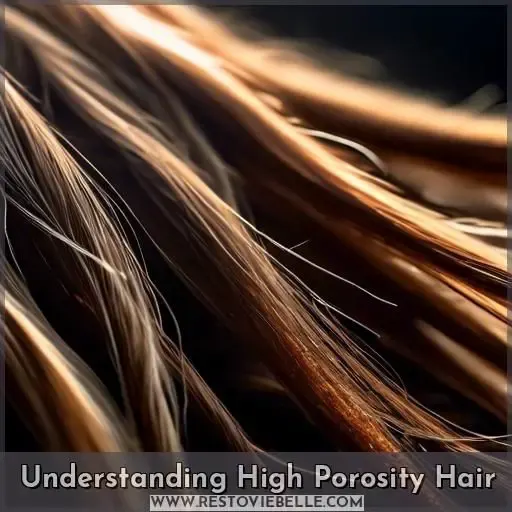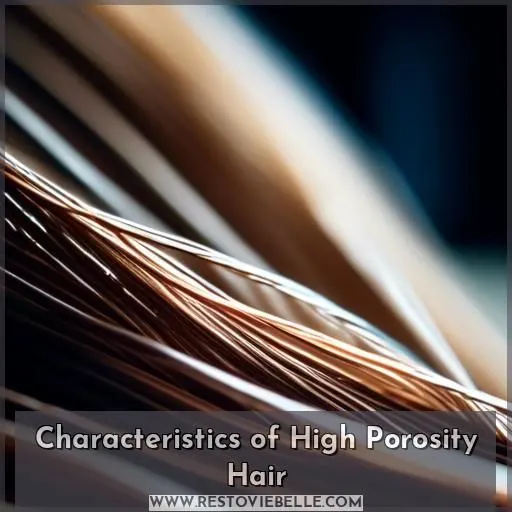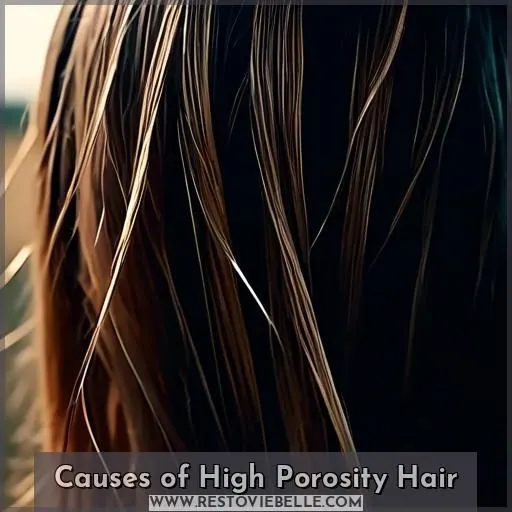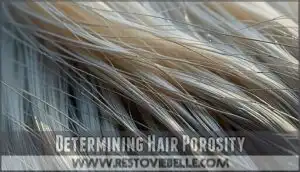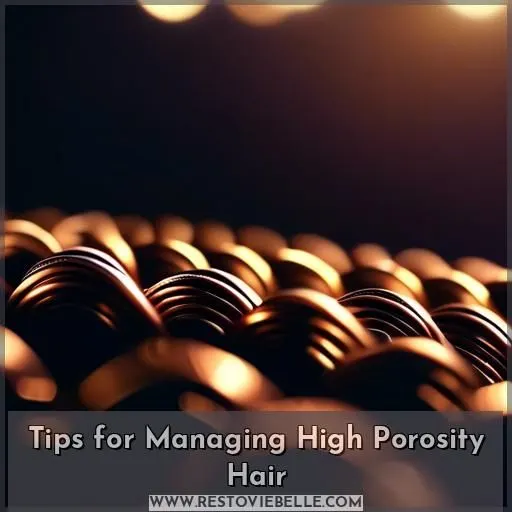This site is supported by our readers. We may earn a commission, at no cost to you, if you purchase through links.
Your high porosity hair has raised, damaged cuticles that allow moisture to be easily absorbed and just as quickly lost.
You’ll notice fast water absorption, quick drying times, tangles, frizz, and difficulty holding styles.
Genetics play a role, but heat, chemicals, and bleaching exacerbate the issue over time.
To identify high porosity, try the float, strand, or water slide tests.
While this hair type takes color well, proper care is crucial to prevent further damage and dehydration.
By understanding its unique needs, you can unlock the secrets to lush, hydrated locks.
Table Of Contents
Key Takeaways
- High porosity hair has raised, damaged cuticles that allow for quick moisture absorption but struggle to retain it, leading to dryness, frizz, and difficulty holding styles.
- Genetics play a role, but heat, chemicals, and bleaching can exacerbate the issue over time.
- To identify high porosity hair, try the float, strand, or water slide tests.
- Proper care includes avoiding sulfates, parabens, silicones, and sodium lauryl sulfates, using lukewarm water for washing and conditioning, minimizing heat styling, and opting for specific hair care products.
Understanding High Porosity Hair
Embark on the journey to understanding high porosity hair – a type of hair that’s highly absorbent and prone to dryness, frizz, and damage. High porosity hair, as the name suggests, has a raised or damaged cuticle layer, which allows for easy moisture absorption but also quick escape. This type of hair is notorious for its ability to quickly absorb products, but struggle to retain them, leading to a cycle of dryness and frizz. It’s essential to know the signs and causes of high porosity hair to tailor your hair care routine effectively.
High porosity hair is characterized by its ability to absorb moisture easily, but struggle to retain it. This can lead to dryness, frizz, and damage from external factors like heat and chemical treatments. Some common causes of high porosity hair include genetics, heat styling, chemical treatments, and bleaching.
To determine if you have high porosity hair, observe if it quickly absorbs water, dries out fast, tangles easily, frizzes easily, absorbs products quickly, has difficulty holding styles, and appears dense or porous. High porosity hair isn’t necessarily weak, but it can be more prone to damage and dryness due to its open cuticle structure.
Managing high porosity hair requires specific care. For example, avoid sulfates, parabens, silicones, and sodium laureth sulfates in your hair products. Use lukewarm water for washing and conditioning, and dry your hair with a cotton T-shirt. Minimize heat styling and use heat styling appliances on a lower heat setting with heat protecting products.
Characteristics of High Porosity Hair
High porosity hair is a challenge that many naturals face, but understanding its characteristics can help you manage it effectively. This type of hair has raised, damaged cuticles that absorb moisture easily but struggle to retain it. This results in frizzy, dry, and coarse curls that are prone to tangling and over-processing. High porosity hair also takes color well, but it’s essential to be cautious to avoid damaging the hair further.
When it comes to product selection, avoid sulfates, parabens, silicones, and sodium laureth sulfates. Instead, opt for shampoos like Devacurl No-Poo Decadence Milk Cleanser and L’Oreal Paris Elvive Total Repair 5 Repairing Shampoo. Conditioners such as Neutrogena Triple Moisture Daily Deep Conditioner and SheaMoisture Manuka Honey & Mafura Oil Intensive Hydration Hair Conditioner are also beneficial. Deep conditioners like SheaMoisture High Porosity Moisture Correct Masque and Marc Anthony Grow Long Anti-Breakage Hair Mask can help restore moisture and prevent breakage.
Managing high porosity hair involves using lukewarm water for washing and conditioning, drying with a cotton T-shirt, and minimizing heat styling. If possible, use heat styling appliances on a lower heat setting and with heat protecting products like L’Oreal Paris Advanced Hairstyle BLOW DRY IT Thermal Smoother Cream and Sun Bum Revitalizing 3-in-1 Leave-In Hair Conditioner Spray.
Signs of High Porosity Hair
High porosity hair is a common concern for many individuals with natural hair, as it can lead to dryness, frizziness, and breakage.
- Quick absorption of water or products: High porosity hair has gaps in the cuticle layer, which allows for rapid moisture intake. This means your hair may dry quickly after washing or get wet easily, even in humid conditions.
- Dryness and dehydration: Your hair may feel dry and lack shine, as it has difficulty retaining moisture.
- Frizziness: High porosity hair is more prone to frizz, as it can quickly absorb moisture from the atmosphere and lose it just as fast.
- Tangling and breakage: The open cuticles of high porosity hair make it more susceptible to tangling and breakage.
- Air dries quickly: High porosity hair tends to dry out quickly after washing, as it absorbs moisture from the air and loses it rapidly.
If you notice these signs, it’s essential to adjust your hair care routine to accommodate your hair’s porosity. This may include using moisturizing and protein-rich hair care products, such as sulfate-free shampoos, deep conditioners, regular protein treatments, and leave-in conditioners. Additionally, avoiding excessive heat styling and harsh chemicals, and protecting your hair from environmental damage can help maintain the health of your high porosity hair. Regular trims to prevent split ends are also beneficial.
Causes of High Porosity Hair
You could inherit high porosity hair due to your genetic makeup, making your strands more susceptible to cuticle damage and excessive moisture absorption. Additionally, hair processing techniques like chemical relaxers, excessive heat styling, and bleaching compromise the cuticle layer, leading to raised cuticles and increased porosity over time.
Genetic Influence Factors
Genetics play a significant role in determining hair porosity.
The structure of the hair cuticle, which is the outermost layer of the hair shaft, is largely influenced by genetics.
This cuticle layer is tightly bound in low porosity hair, making it difficult for moisture to penetrate and escape.
In contrast, high porosity hair has gaps and openings in the cuticle layer, allowing moisture to easily pass in and out.
These differences in cuticle structure can lead to individual differences in hair porosity levels.
Styling and Chemical Damage
High porosity hair is more prone to damage due to its raised cuticle structure, which easily absorbs moisture but struggles to retain it.
Heat styling tools and chemical treatments can exacerbate this issue, leading to further damage.
To manage high porosity hair, it’s crucial to avoid excessive heat styling and harsh chemical treatments.
Opt for sulfate-free shampoos, deep conditioners, and regular protein treatments to strengthen the hair cuticles.
Additionally, use heat protectant sprays and protective hairstyles like braids, twists, or updos to minimize damage.
Regular trims and moisturizing with leave-in conditioners and hair oils can also help maintain the hair’s elasticity and prevent dryness and frizz.
Cuticle Condition Indicators
High porosity hair is characterized by damaged cuticles, which can be caused by genetic factors and hair processing treatments.
To manage high porosity hair, it’s crucial to avoid sulfates, parabens, silicones, and sodium laureth sulfates.
Use lukewarm water for washing and conditioning.
Dry hair with a cotton T-shirt.
Minimize heat styling and use heat styling appliances on a lower heat setting with heat protecting products.
Seal in moisture with a butter and oil blend.
Protect hair with a satin cap or scarf at night.
Regular trims, deep conditioning with hydrolyzed proteins, and using twist-outs, Bantu knot-outs, or twist-and-curls can also help manage high porosity hair.
Determining Hair Porosity
When it comes to managing high porosity hair, the first step is understanding your hair’s porosity. High porosity hair, characterized by raised, damaged cuticles, absorbs moisture easily but struggles to retain it.
- Float Test: Place a strand of hair in a glass of water. If it floats, it’s low porosity. If it sinks, it’s high porosity.
- Strand Test: Wet a strand of hair and stretch it between your fingers. If it stretches out easily, it’s high porosity.
- Bleach Test: Apply bleach to a strand of hair. If it absorbs quickly, it’s high porosity.
- Water Slide Test: Wet a strand of hair and slide your fingers down it. If it feels rough and bumpy, it’s high porosity.
- Dye Test: Apply dye to a strand of hair. If it absorbs quickly and evenly, it’s high porosity.
Tips for Managing High Porosity Hair
Managing high porosity hair can be a daunting task, but with the right tips and techniques, you can unlock its full potential.
- Embrace the Curly Girl Method (CGM): Ditch sulfates, parabens, silicones, and sodium laureth sulfates in your hair routine. This will help retain moisture and reduce frizz, ensuring optimal moisture retention.
- Protein Treatments: Regular protein treatments can significantly improve the health and strength of high porosity hair. They help to restore damaged cuticles and strengthen the hair shaft, making it more resilient to breakage.
- Moisture Retention: High porosity hair absorbs moisture easily but struggles to retain it. Use leave-in conditioners with emollients, deep condition with hydrolyzed proteins, and consider using anti-humectant products to seal in moisture.
- Styling Techniques: Minimize heat styling and use heat styling appliances on a lower heat setting with heat protecting products. Opt for protective styling methods like twist-outs, Bantu knot-outs, or twist-and-curls to distribute moisture evenly and reduce breakage.
- Regular Trims: Regular trims are crucial for high porosity hair, as they help to preserve hair health and prevent split ends. Additionally, deep condition with hydrolyzed proteins twice a month to maintain hair health and ensure even moisture distribution.
Treatments for High Porosity Hair
High porosity hair is known for its ability to absorb moisture easily but struggle to retain it. This can lead to a variety of issues, including frizz, dryness, and breakage. To combat these problems, there are several treatments you can incorporate into your hair care routine.
- Protein Treatments: High porosity hair is prone to damage and breakage, so incorporating protein treatments can help fortify the hair and reduce breakage. Look for products with keratin, wheat, or silk protein, which are all effective at strengthening high porosity hair.
- ACV Rinses: An apple cider vinegar (ACV) rinse can help seal the cuticle and lock in moisture. Mix equal parts ACV and water, apply to your hair, and rinse out after a few minutes for a refreshed, moisturized look.
- Cold Water Rinses: Rinsing your hair with cold water after washing can help close the cuticle and seal in moisture. This is especially beneficial for high porosity hair, which tends to dry quickly.
- Hair Masks: Deep conditioning treatments can provide extra moisture and nourishment to high porosity hair. Try using a hair mask once or twice a week to help combat dryness and frizz.
- Styling Tips: Opt for cream or oil-based styling products to help retain moisture. Layering both creams and oils can give your hair the hydration it needs while also sealing it in.
Frequently Asked Questions (FAQs)
What are the signs of high porosity hair?
You’ll notice your hair feels dry, frizzy, and tangles easily. It absorbs products rapidly but struggles to retain moisture. Your tresses also look dull and lack shine.
How does high porosity hair affect hair care?
Imagine your hair is a sponge – highly porous strands gulp moisture greedily, only to have it seep out within hours. Frizz, brittleness, and thirst become your daily battles.
What are the best hair care products for high porosity hair?
You’ll want to use ultra-moisturizing products like creamy deep conditioners, intense hydrating masks, and butter-rich leave-ins to nourish parched strands.
How can high porosity hair be managed effectively?
You’ve got to give high porosity locks some serious TLC! Use protein masks, cold rinses, and avoid sulfates to seal those cuticles tight. Finish with oils and butters to retain all that glorious moisture.
What are the most common causes of high porosity hair?
Hair porosity can skyrocket from heat styling, bleaching, chemical treatments, or even genetics. By some twist of fate, those erratic cuticles let moisture gush in but struggle to trap it – a recipe for dry, frizzy strands.
Conclusion
You’ve navigated the complexities of high porosity hair. Like a thirsty sponge, its raised cuticles eagerly drink moisture but struggle to retain it. Embrace this unique texture by pampering it with nourishing treatments and gentle handling. With patience and the right routine tailored for high porosity locks, you’ll unveil the secrets to lush, hydrated strands.


